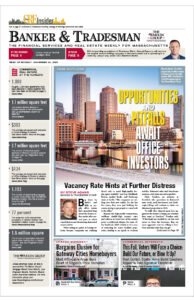
In an otherwise quiet quarter for office leasing in Boson, Lego Group selected Samuels & Associates' 101 Massachusetts Ave. project in Back Bay for its new U.S. headquarters. Photo by Steve Adams | Banker & Tradesman Staff
Tenant demand for office space in Boston has started to recover from the economic blows delivered by Federal Reserve’s interest-rate tightening, but rents declined and vacancies rose as companies take a cautious approach to making real estate commitments.
Over the past 12 months, office tenants’ active space requirements have increased nearly 26 percent, according to new JLL research.
“The process is a little bit slower and a lot of tenants are hearing that it’s an opportunistic market, so they see an opportunity to get a better deal and a better space,” JLL Senior Research Analyst Bryan Montgomery said.
Asking rents for class A office space in Boston declined 2.4 percent from the previous quarter and 6.6 percent from the previous year to $52 per square foot, according to JLL Boston’s third-quarter office report released this week.
Nearly 3.4 million square feet of office space is under construction and buildings such as Hines’ South Station tower, Boston Global Investors’ 10 World Trade Center and Leggat McCall’s 40 Thorndike in East Cambridge are positioned to capture tenants’ preference for brand-new space.
But the supply of new inventory will decline sharply starting in 2025. Only one large-scale office project is currently proposed in Boston: Midwood Investment & Development’s 11-21 Bromfield St., which would replace a cluster of buildings in Downtown Crossing with a 23-story, 410,700-square-foot tower.
Year-to-date, the region’s office market totaled 4.1 million square feet of negative absorption, ending the third quarter with a vacancy rate of 19.8 percent.
In the quarter’s most notable transaction, Lego selected Samuels & Assoc.’s parcel 12 project at 101 Massachusetts Ave. in the Back Bay for its new U.S. headquarters, leasing 134,000 square feet.
Sublease activity continues to add availabilities to the market, including a 139,000-square-foot office listing by 2seventybio at 60 Binney St. in Cambridge, and 90,000 square feet at 1601 Trapelo Road in Waltham by Dynatrace.
The Boston office market’s heavy component of finance, insurance, real estate and legal industry tenants has been a stabilizing influence in comparison to other high-priced coastal metros, insulating the market from the worst effects of the post-pandemic office downturn, Montgomery said.
But vacancy rates are expected to continue rising in the near term, as many tenants consolidate and shrink their office space requirements when signing new leases.








